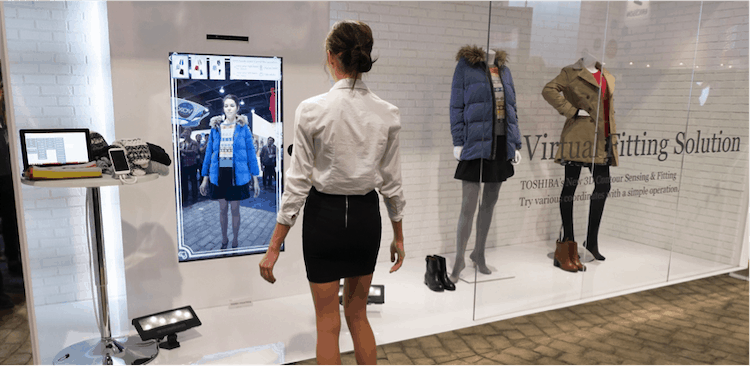Did you know that 81% of brands expect to reduce the number of product returns thanks to augmented reality?
As you can see, this technology offers much more than an immersive visual experience! It reduces the number of customer returns, which in turn leads to a significant reduction in logistics costs for e-tailers and helps to reduce environmental impact. In this article, find out how augmented reality can become your strategic ally in optimising your bottom line.
1. Augmented reality: a must for 2024
Augmented reality (AR) is a technology that enriches our perception of the real world by superimposing virtual elements. It is increasingly used in the retail world to transform and enhance the customer experience. The growth prospects for the global market for this technology are promising, with a forecast annual growth rate of 13.72% between 2023 and 2027, reaching a market size of $52.05 billion by 2027 (Statista).
In practical terms, superimposing virtual elements on the real world makes it easier for users to make decisions, improves their engagement with a brand and makes their shopping experience more pleasant and personalised. The impact on retailers who have integrated augmented reality into their strategy is tangible, with a 19% increase in customer engagement. Augmented reality is a technology that needs to be urgently adopted in the retail sector.
2. Major uses of augmented reality in online shopping
2.1 Virtual product testing
Virtual product trials are reinventing the way consumers interact with products before making a purchase. This fusion of the strengths of new digital tools, online retailing and traditional retailing offers many opportunities for your business. Let’s look at a few examples:
- In the beauty sector, brands such as L’Oréal allow customers to try on make-up virtually, which has led to a significant increase in sales and conversion rates.
- In fashion, innovative brands such as Auroboros and Converse even offer digital clothing, allowing users to try them on in virtual environments before purchasing them.
- The furniture sector is no exception, with companies like IKEA allowing customers to virtually visualise furniture in their own homes.
These augmented reality applications offer customers an unprecedented level of interaction with products, enabling them to make more informed choices and enjoy a more rewarding shopping experience. What’s more, 73% of consumers believe that augmented reality can have a positive impact on the environment by reducing returns (Ipsos).
2.2 Personalising the customer experience
The personalisation of the customer experience thanks to augmented reality is opening up new horizons for retail. To meet the increasingly demanding expectations of consumers looking for a unique and memorable shopping experience, some brands have already begun to exploit this technology to offer an ultra-personalised experience:
- Product personalisation: By allowing customers to view a product in a real environment (e.g. their own home) or to customise product options according to their preferences, AR creates a unique and individualised shopping experience.
- Personalising the shopping journey: AR can also be used to create personalised shopping journeys in-store. For example, an augmented reality application can guide customers around the shop based on their preferences and purchase history.
- Personalised customer service: AR can improve customer service by providing personalised information in real time. For example, a virtual advisor can help customers make their choice by providing personalised advice.
In short, augmented reality offers new opportunities for personalising the customer experience at every stage of the buying journey, from acquisition to conversion.
3. How does augmented reality impact your brand promotion?
3.1 Changing the shopping experience
As we have just seen, the shopping experience, traditionally rooted in the concrete and tangible, is now undergoing a major transformation thanks to augmented reality. AR is transforming the way people shop, enriching the interaction between your customers and your products. As a result, your customer’s buying experience will become smoother and more personalised. AR gives brands new opportunities to interact with consumers in real time, offering a new level of customer service.
But the growing adoption of augmented reality is part of an even wider trend. Indeed, 72% of consumers are interested in using augmented reality to interact with a product before buying it (Ipsos). People are getting used to using artificial intelligence and interacting with it on a daily basis. Their confidence in all things digital is growing by the day.
As digital technology proves its effectiveness, mainstream adoption becomes an indisputable reality. Digital interactions, such as those offered by augmented reality, are not only becoming more natural, they are now even a legitimate expectation on the part of consumers, demonstrating their openness to experiences of this kind.
3.2 Adapting brands to this new technology
Faced with the emergence of augmented reality, many brands in the retail sector are transforming their strategy. These adaptations are taking place in a variety of ways.
First of all, the incorporation of AR into physical shops makes it possible to offer a unique shopping experience, combining the best of the digital and real worlds. Connected mirrors are a good example of this, and are particularly popular in the fashion sector.
Secondly, e-commerce is using AR to enrich the online shopping experience. Giants such as Amazon and Google are offering their customers the opportunity to view products in their real-life environment before purchasing, thereby increasing consumer confidence and sales conversion.
Finally, some brands are using AR as an innovative marketing technique. By offering immersive experiences, they can engage their customers more effectively and raise their profile on social networks, which have become the preferred platforms for sharing these experiences.
These adaptations reflect the gradual and inevitable digital transformation of the retail sector, driven by augmented reality.
3.3 The role of augmented reality in building customer loyalty
Augmented reality plays a crucial role in building customer loyalty in retail. With its potential to create immersive, personalised shopping experiences, this technology keeps customers coming back for more.
97% of consumers would be interested in using augmented reality experiences after purchase.
AR offers innovative solutions for maintaining and strengthening communication with customers after they have made a purchase. What’s more, you can use AR to set up attractive loyalty programmes. By rewarding customers with unique and personalised AR experiences, retailers can encourage long-term engagement.
Augmented reality also offers a new dimension to after-sales service. Imagine if IKEA offered you an augmented reality assembly guide to assemble your new wardrobe. Wouldn’t this offer be an essential loyalty-building tool?
Building customer loyalty through AR is not just a question of technology, but also of strategy. Missing out on this opportunity represents a considerable risk of being left behind by the competition. The brands that succeed in integrating augmented reality into their customer relations in the right way will be the ones to benefit most from this innovative technology.
Innovation and disruption thanks to augmented reality
Augmented reality is driving innovation and disruption in the retail sector. This technology goes beyond improving the customer experience to offer a whole new way of thinking about retail.
- Redefining business models: AR allows retailers to explore new retail models. For example, virtual shopping offers customers an immersive brand experience without them having to leave their homes.
- Optimising merchandising: AR provides retailers with valuable information about customer behaviour towards their products, and helps them to adopt appropriate merchandising.
- Enriching the shopping experience: AR can now be used at different stages in the sale of a product, making for a smoother shopping experience.
- Promoting your brand: AR can be used to promote brands in innovative and engaging ways, enabling them to reinvent themselves.
In short, augmented reality is revolutionising retail, adding a new dimension to commerce and offering unprecedented opportunities for retailers who are ready to integrate this technology into their digital strategy.
Future prospects for augmented reality in retail
Immersion and interactivity will be the watchwords over the coming months. The digital retail trends of 2024 point to an increased convergence of retail and e-commerce, where augmented reality will play a major role.
In the future, augmented reality could be used to :
- Enhance the customer experience even further;
- Boost marketing campaigns;
- Revitalise the service offering.
3D scanning technology could also play an important role in the future of augmented reality in retail. 3D scanning could, for example, be used to create accurate reproductions of products or to allow customers to virtually try on clothes before buying them.

So the future looks bright for augmented reality in retail, with a host of new applications and opportunities to explore. So why not adopt it now? Position yourself as a leader in 2024 and beyond.




